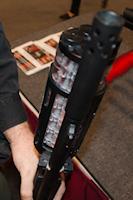Overview of the RCI X-Rail
Most of the information in this post was sourced from RCI's website, including their instruction manuals. Pictures and what I recall, are from my inspection of their product at the 2013 SHOT show. I cannot speak from experience in firing this product, but I did examine it at the show. Roth Concept Innovations's X-Rail is one of the newer solutions to the question of how to get more capacity in a tube-fed shotgun. Like some of the other extension devices, it relies upon a rotary magazine extension which allows shells to be stored in extra tube extensions instead of a straight line out the barrel. As of Apr 1 2014, it's available for:- Remington 870, 1187, 1100, and Versa Max
- Benelli SBE, SBE2, M1, and M2
- Mossberg 930
- Winchester SX3
- FNH SLP (requires additional replacement mag tube to work)
Pictures
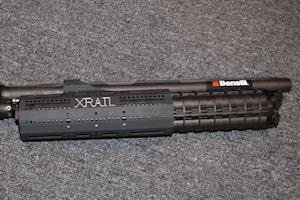 A side view of the full version X-Rail, installed on a Benelli shotgun. The metal housing attaches to the top of the barrel, and the magazine tube extensions run forward.
A side view of the full version X-Rail, installed on a Benelli shotgun. The metal housing attaches to the top of the barrel, and the magazine tube extensions run forward.
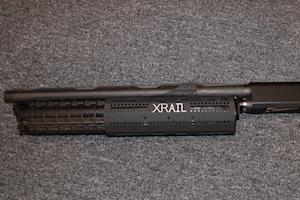 The other side of the full version. Note that the adapter, on this shotgun, occupies the space where the magazine tube would normally reside.
The other side of the full version. Note that the adapter, on this shotgun, occupies the space where the magazine tube would normally reside.
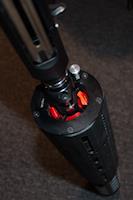 Underside of the full version. At the top of the image, one can see the feed ramp. One loads the X-Rail just like any ordinary tube fed shotgun.
Underside of the full version. At the top of the image, one can see the feed ramp. One loads the X-Rail just like any ordinary tube fed shotgun.
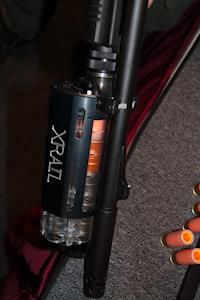 This is the compact version, which is available in either a black tube like the one above or a clear version. This is a side view of the compact X-Rail. Due to the transparent plastic involved, it's possible to see the springs compressing as shells are fed into the X-Rail adapter.
This is the compact version, which is available in either a black tube like the one above or a clear version. This is a side view of the compact X-Rail. Due to the transparent plastic involved, it's possible to see the springs compressing as shells are fed into the X-Rail adapter.
 The small piece I'm pulling here is the indexing pin, which locks the X-Rail to the primary tube. If you don't pull this pin, the X-Rail won't index, and it will behave like an ordinary tube-fed shotgun. When you intend to load shells into the X-Rail, you first completely load the main tube, then pull this pin so that the X-Rail can index, and then any additional shells being loaded will go into the three auxilliary tubes in sequence. Because the main tube's spring is much longer than the others (necessary so that it can push shells all the way to the end of the tube), rotating the barrel before loading the tube will result in the main spring being caught in the X-Rail assembly as it rotates, possibly damaging it in the process. There aren't any real engineering ways around this risk, so the indexing pin isn't a bad idea.
The small piece I'm pulling here is the indexing pin, which locks the X-Rail to the primary tube. If you don't pull this pin, the X-Rail won't index, and it will behave like an ordinary tube-fed shotgun. When you intend to load shells into the X-Rail, you first completely load the main tube, then pull this pin so that the X-Rail can index, and then any additional shells being loaded will go into the three auxilliary tubes in sequence. Because the main tube's spring is much longer than the others (necessary so that it can push shells all the way to the end of the tube), rotating the barrel before loading the tube will result in the main spring being caught in the X-Rail assembly as it rotates, possibly damaging it in the process. There aren't any real engineering ways around this risk, so the indexing pin isn't a bad idea.
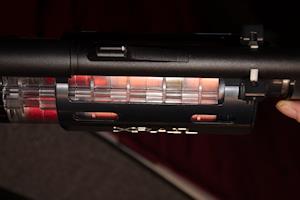 The X-Rail, with a few shells loaded.
The X-Rail, with a few shells loaded.
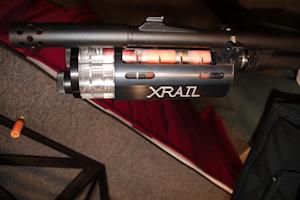 The X-Rail, with a few more shells loaded. Note the "jaws" or "fingers" which attach to the top of the rail. They are tightened down via set screws, and then sealed with a thread fastener such as Lock-Tite. There are also set screws on the bottom, so that the X-Rail clamps on with tension from both above and below the barrel.
The X-Rail, with a few more shells loaded. Note the "jaws" or "fingers" which attach to the top of the rail. They are tightened down via set screws, and then sealed with a thread fastener such as Lock-Tite. There are also set screws on the bottom, so that the X-Rail clamps on with tension from both above and below the barrel.
-- SeanNewton - 01 Apr 2014
 Copyright © by the contributing authors. All material on this collaboration platform is the property of the contributing authors.
Copyright © by the contributing authors. All material on this collaboration platform is the property of the contributing authors. Ideas, requests, problems regarding Foswiki? Send feedback

